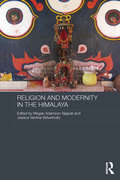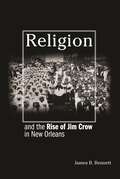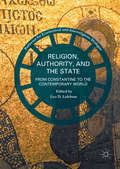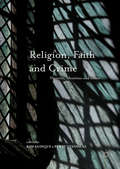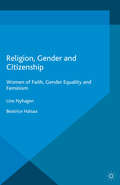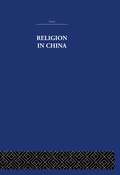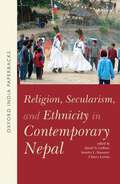- Table View
- List View
Releasing the Commons: Rethinking the futures of the commons (Routledge Studies in Human Geography)
by Ash Amin Philip HowellThis book moves beyond seeing the commons in the past tense, an entity passed over from the public into the private, to reimagine the commons as a process, a contest of force, a reconstitution, and a site of convening practices. It highlights new spaces of gathering opening up, such as the digital commons, and new practices of being in common, such as community economies and solidarity networks. The commons is seen as a contested domain of the collective and as a changing way of being in common, with the balance poised in the tensile play between political economy and social innovation. The book focuses on the possibility of recovering a future in which more can be held by the many, focusing on three concepts: nation and nature as a commons, publics and rights, and bodies, concerning the management of lives and livelihoods. Across these three passage points, the book finds evidence of a commons under attack but also defended in fragile though promising ways. With contributions from leading scholars, this thought provoking book will be of great interest to students and scholars in geography, environmental studies, politics, anthropology, and cultural studies.
Releasing the Commons: Rethinking the futures of the commons (Routledge Studies in Human Geography)
by Ash Amin and Philip HowellThis book moves beyond seeing the commons in the past tense, an entity passed over from the public into the private, to reimagine the commons as a process, a contest of force, a reconstitution, and a site of convening practices. It highlights new spaces of gathering opening up, such as the digital commons, and new practices of being in common, such as community economies and solidarity networks. The commons is seen as a contested domain of the collective and as a changing way of being in common, with the balance poised in the tensile play between political economy and social innovation. The book focuses on the possibility of recovering a future in which more can be held by the many, focusing on three concepts: nation and nature as a commons, publics and rights, and bodies, concerning the management of lives and livelihoods. Across these three passage points, the book finds evidence of a commons under attack but also defended in fragile though promising ways. With contributions from leading scholars, this thought provoking book will be of great interest to students and scholars in geography, environmental studies, politics, anthropology, and cultural studies.
Religion: Spurensuche im Alltag
by Alfred Bellebaum Robert HettlageFür das moderne Wissenschaftsverständnis und folglich für viele Soziologen ist das Thema Religion unbequem und unattraktiv und wird deshalb nach Möglichkeit umgangen. Diese Tatsache steht in eklatantem Widerspruch zur weltgeschichtlichen Bedeutung des Phänomens Religion, zur Entstehungsgeschichte der Soziologie und zum alltäglichen Leben der Menschen. Zu allen Zeiten haben Menschen auf der Suche nach dem gelingenden Leben zudem immer einen engen Zusammenhang zwischen Religion, Ethik und Glück erahnt. Seit der antiken Philosophie, besonders seit Plato und Aristoteles, wird dieses komplexe Themenfeld in unterschiedlichsten Zuspitzungen diskutiert. Soziologie, die den Sinn und die Strukturen des sozialen, und nicht selten alltäglichen Handelns zum Gegenstand hat, kann sich davon kaum dispensieren.
Religion and Modernity in the Himalaya (Routledge Contemporary South Asia Series)
by Megan Adamson Sijapati Jessica Vantine BirkenholtzReligion has long been a powerful cultural, social, and political force in the Himalaya. Increased economic and cultural flows, growth in tourism, and new forms of governance and media, however, have brought significant changes to the religious traditions of the region in the twentieth and twenty-first centuries. This book presents detailed case studies of lived religion in the Himalaya in this context of rapid change to offer intra-regional perspectives on the ways in which lived religions are being re-configured or re-imagined. Based on original fieldwork, this book documents understudied forms of religion in the region and presents unique perspectives on the phenomenon and experience of religion, discussing why, when, and where practices, discourses, and the category of religion itself, are engaged by varying communities in the region. It yields fruitful insights into both the religious traditions and lived human experiences of Himalayan peoples in the modern era. Presenting new research and perspectives on the Himalayan region, this book should be of interest to students and scholars of South Asian Studies, Religious Studies, and Modernity.
Religion and Modernity in the Himalaya (Routledge Contemporary South Asia Series)
by Megan Adamson Sijapati Jessica Vantine BirkenholtzReligion has long been a powerful cultural, social, and political force in the Himalaya. Increased economic and cultural flows, growth in tourism, and new forms of governance and media, however, have brought significant changes to the religious traditions of the region in the twentieth and twenty-first centuries. This book presents detailed case studies of lived religion in the Himalaya in this context of rapid change to offer intra-regional perspectives on the ways in which lived religions are being re-configured or re-imagined. Based on original fieldwork, this book documents understudied forms of religion in the region and presents unique perspectives on the phenomenon and experience of religion, discussing why, when, and where practices, discourses, and the category of religion itself, are engaged by varying communities in the region. It yields fruitful insights into both the religious traditions and lived human experiences of Himalayan peoples in the modern era. Presenting new research and perspectives on the Himalayan region, this book should be of interest to students and scholars of South Asian Studies, Religious Studies, and Modernity.
Religion and Non-Religion among Australian Aboriginal Peoples (Vitality of Indigenous Religions)
by Adam Possamai James L. CoxOffering a significant contribution to the emerging field of 'Non-Religion Studies', Religion and Non-Religion among Australian Aboriginal Peoples draws on Australian 2011 Census statistics to ask whether the Indigenous Australian population, like the wider Australian society, is becoming increasingly secularised or whether there are other explanations for the surprisingly high percentage of Aboriginal people in Australia who state that they have 'no religion'. Contributors from a range of disciplines consider three central questions: How do Aboriginal Australians understand or interpret what Westerners have called 'religion'? Do Aboriginal Australians distinguish being 'religious' from being 'non-religious'? How have modernity and Christianity affected Indigenous understandings of 'religion'? These questions re-focus Western-dominated concerns with the decline or revival of religion, by incorporating how Indigenous Australians have responded to modernity, how modernity has affected Indigenous peoples' religious behaviours and perceptions, and how variations of response can be found in rural and urban contexts.
Religion and Non-Religion among Australian Aboriginal Peoples (Vitality of Indigenous Religions)
by Adam Possamai James L. CoxOffering a significant contribution to the emerging field of 'Non-Religion Studies', Religion and Non-Religion among Australian Aboriginal Peoples draws on Australian 2011 Census statistics to ask whether the Indigenous Australian population, like the wider Australian society, is becoming increasingly secularised or whether there are other explanations for the surprisingly high percentage of Aboriginal people in Australia who state that they have 'no religion'. Contributors from a range of disciplines consider three central questions: How do Aboriginal Australians understand or interpret what Westerners have called 'religion'? Do Aboriginal Australians distinguish being 'religious' from being 'non-religious'? How have modernity and Christianity affected Indigenous understandings of 'religion'? These questions re-focus Western-dominated concerns with the decline or revival of religion, by incorporating how Indigenous Australians have responded to modernity, how modernity has affected Indigenous peoples' religious behaviours and perceptions, and how variations of response can be found in rural and urban contexts.
Religion and the Rise of Jim Crow in New Orleans
by James B. BennettReligion and the Rise of Jim Crow in New Orleans examines a difficult chapter in American religious history: the story of race prejudice in American Christianity. Focusing on the largest city in the late-nineteenth-century South, it explores the relationship between churches--black and white, Protestant and Catholic--and the emergence of the Jim Crow laws, statutes that created a racial caste system in the American South. The book fills a gap in the scholarship on religion and race in the crucial decades between the end of Reconstruction and the eve of the Civil Rights movement. Drawing on a range of local and personal accounts from the post-Reconstruction period, newspapers, and church records, Bennett's analysis challenges the assumption that churches fell into fixed patterns of segregation without a fight. In sacred no less than secular spheres, establishing Jim Crow constituted a long, slow, and complicated journey that extended well into the twentieth century. Churches remained a source of hope and a means of resistance against segregation, rather than a retreat from racial oppression. Especially in the decade after Reconstruction, churches offered the possibility of creating a common identity that privileged religious over racial status, a pattern that black church members hoped would transfer to a national American identity transcending racial differences. Religion thus becomes a lens to reconsider patterns for racial interaction throughout Southern society. By tracing the contours of that hopeful yet ultimately tragic journey, this book reveals the complex and mutually influential relationship between church and society in the American South, placing churches at the center of the nation's racial struggles.
Religion and Urbanism: Reconceptualising sustainable cities for South Asia (Routledge Research in Religion and Development)
by Yamini NarayananConceptions of 'sustainable cities' in the pluralistic and multireligious urban settlements of developing nations need to develop out of local cultural, religious and historical contexts to be inclusive and accurately respond to the needs of the poor, ethnic and religious minorities, and women. Religion and Urbanism contributes to an expanded understanding of 'sustainable cities' in South Asia by demonstrating the multiple, and often conflicting ways in which religion enables or challenges socially equitable and ecologically sustainable urbanisation in the region. In particular, this collection focuses on two aspects that must inform the sustainable cities discourse in South Asia: the intersections of religion and urban heritage, and religion and various aspects of informality. This book makes a much-needed contribution to the nexus between religion and urban planning for researchers, postgraduate students and policy makers in Sustainable Development, Development Studies, Urban Studies, Religious Studies, Asian Studies, Heritage Studies and Urban and Religious Geography.
Religion and Urbanism: Reconceptualising sustainable cities for South Asia (Routledge Research in Religion and Development)
by Yamini NarayananConceptions of 'sustainable cities' in the pluralistic and multireligious urban settlements of developing nations need to develop out of local cultural, religious and historical contexts to be inclusive and accurately respond to the needs of the poor, ethnic and religious minorities, and women. Religion and Urbanism contributes to an expanded understanding of 'sustainable cities' in South Asia by demonstrating the multiple, and often conflicting ways in which religion enables or challenges socially equitable and ecologically sustainable urbanisation in the region. In particular, this collection focuses on two aspects that must inform the sustainable cities discourse in South Asia: the intersections of religion and urban heritage, and religion and various aspects of informality. This book makes a much-needed contribution to the nexus between religion and urban planning for researchers, postgraduate students and policy makers in Sustainable Development, Development Studies, Urban Studies, Religious Studies, Asian Studies, Heritage Studies and Urban and Religious Geography.
Religion, Authority, and the State: From Constantine to the Contemporary World (Pathways for Ecumenical and Interreligious Dialogue)
by Leo D. LefebureIn commemoration of Constantine’s grant of freedom of religion to Christians, this wide-ranging volume examines the ambiguous legacy of this emperor in relation to the present world, discussing the perennial challenges of relations between religions and governments. The authors examine the new global ecumenical movement inspired by Pentecostals, the role of religion in the Irish Easter rebellion against the British, and the relation between religious freedom and government in the United States. Other essays debate the relation of Islam to the violence in Nigeria, the place of the family in church-state relations in the Philippines, the role of confessional identity in the political struggles in the Balkans, and the construction of Slavophile identity in nineteenth-century Russian Orthodox political theology. The volume also investigates the contrast between written constitutions and actual practice in the relations between governments and religions in Australia, Indonesia, and Egypt. The case studies and surveys illuminate both specific contexts and also widespread currents in religion-state relations across the world.
Religion, Equalities, and Inequalities (Theology and Religion in Interdisciplinary Perspective Series in Association with the BSA Sociology of Religion Study Group)
by Dawn Llewellyn Sonya SharmaPresenting cutting edge research on how religion can confront and obscure social inequalities in everyday life, Religion, Equalities and Inequalities argues that when religion is left out of social scientific analyses, it can result in incomplete analyses that conceal pathways to social inclusion and exclusion. Bringing together an international and interdisciplinary group of contributors who operate at the vanguard of theoretical and empirical work on how social structures of power, institutions and bodies can generate equalities and inequalities in religion, the collection shows how religion can enable and challenge the inequities that affect people’s everyday lives. Academics and students of religious studies, sociology, politics and social policy will all find this book offers useful insights into the relationship between religion and contemporary culture.
Religion, Equalities, and Inequalities (Theology and Religion in Interdisciplinary Perspective Series in Association with the BSA Sociology of Religion Study Group)
by Dawn Llewellyn Sonya SharmaPresenting cutting edge research on how religion can confront and obscure social inequalities in everyday life, Religion, Equalities and Inequalities argues that when religion is left out of social scientific analyses, it can result in incomplete analyses that conceal pathways to social inclusion and exclusion. Bringing together an international and interdisciplinary group of contributors who operate at the vanguard of theoretical and empirical work on how social structures of power, institutions and bodies can generate equalities and inequalities in religion, the collection shows how religion can enable and challenge the inequities that affect people’s everyday lives. Academics and students of religious studies, sociology, politics and social policy will all find this book offers useful insights into the relationship between religion and contemporary culture.
Religion, Faith and Crime: Theories, Identities and Issues
by Kim Sadique Perry StanislasThis unique collection brings together international contributors from a range of disciplines to explore crime and responses to crime through a religious/faith-based lens. At a time when religion is under the media spotlight in terms of religiously-motivated hate crime, terrorism and child abuse this book provides an important platform for academic debate. It examines these and other key issues including: faith as a coping strategy, religion as a motivating factor and the role of religion and morality in shaping criminal justice responses. This collection clearly places religion/faith at the heart of criminological enquiry and illustrates its relevance in addressing wider social issues and would be of benefit to students and academics researching or studying in these areas. It will also be of interest to community and criminal justice practitioners and those with an interest in community engagement and multi-faith work.
Religion, Gender and Citizenship: Women of Faith, Gender Equality and Feminism (Citizenship, Gender and Diversity)
by Line Nyhagen B. HalsaaHow do religious women talk about and practise citizenship? How is religion linked to gender and nationality? What are their views on gender equality, women's movements and feminism? Via interviews with Christian and Muslim women in Norway, Spain and the UK, this book explores intersections between religion, citizenship, gender and feminism.
Religion in China
by K. Hughes E. R. HughesFirst published in 1950.Beginning with ancient times, this volume shows how some of the early superstitions became purified through the influence of the Confucianist philosophy, how a deep strain of mysticism came from the Taoists and how thereby a worship of 'Heaven' and 'Earth' was evolved. Besides the main streams of Confucianism and Buddhism, the introduction and development of Christianity into China is also analyzed.
Religion in China
by K. Hughes E. R. HughesFirst published in 1950.Beginning with ancient times, this volume shows how some of the early superstitions became purified through the influence of the Confucianist philosophy, how a deep strain of mysticism came from the Taoists and how thereby a worship of 'Heaven' and 'Earth' was evolved. Besides the main streams of Confucianism and Buddhism, the introduction and development of Christianity into China is also analyzed.
Religion in the Media: A Linguistic Analysis
by Salman Al-AzamiThis ground-breaking book takes an interdisciplinary approach to language, religion and media using an audience-response study. In this book, the author investigates how the three Abrahamic faiths - Christianity, Judaism and Islam - are represented in mainstream British media and analyses how members of each religious group and those with no religion receive those representations. Employing Critical Discourse Analysis, Al-Azami considers the way the media use their power of language to influence the audience’s perceptions of the three religions through newspaper articles, television documentaries and television dramas. Chapter 3 presents the results of an original investigation into the responses of members of the three religious groups and those with no religion when exposed to those same media materials. The author applies the encoding/decoding model and also considers people’s views in face-to-face interactions compared to comments on online newspapers. Comprehensive in its analysis, this book will be of interest to students of Linguistics, Media Studies, Religious Studies, and Journalism.
Religion, Law and Intolerance in Indonesia (Routledge Law in Asia)
by Tim Lindsey Helen PausackerDespite its overwhelmingly Muslim majority, Indonesia has always been seen as exceptional for its diversity and pluralism. In recent years, however, there has been a rise in "majoritarianism", with resurgent Islamist groups pushing hard to impose conservative values on public life – in many cases with considerable success. This has sparked growing fears for the future of basic human rights, and, in particular, the rights of women and sexual and ethnic minority groups. There have, in fact, been more prosecutions of unorthodox religious groups since the fall of Soeharto in 1998 than there were under the three decades of his authoritarian rule. Some Indonesians even feel that the pluralism they thought was constitutionally guaranteed by the national ideology, the Pancasila, is now under threat. This book contains essays exploring these issues by prominent scholars, lawyers and activists from within Indonesia and beyond, offering detailed accounts of the political and legal implications of rising resurgent Islamism in Indonesia. Examining particular cases of intolerance and violence against minorities, it also provides an account of the responses offered by a weak state that now seems too often unwilling to intervene to protect vulnerable minorities against rising religious intolerance.
Religion, Law and Intolerance in Indonesia (Routledge Law in Asia)
by Tim Lindsey Helen PausackerDespite its overwhelmingly Muslim majority, Indonesia has always been seen as exceptional for its diversity and pluralism. In recent years, however, there has been a rise in "majoritarianism", with resurgent Islamist groups pushing hard to impose conservative values on public life – in many cases with considerable success. This has sparked growing fears for the future of basic human rights, and, in particular, the rights of women and sexual and ethnic minority groups. There have, in fact, been more prosecutions of unorthodox religious groups since the fall of Soeharto in 1998 than there were under the three decades of his authoritarian rule. Some Indonesians even feel that the pluralism they thought was constitutionally guaranteed by the national ideology, the Pancasila, is now under threat. This book contains essays exploring these issues by prominent scholars, lawyers and activists from within Indonesia and beyond, offering detailed accounts of the political and legal implications of rising resurgent Islamism in Indonesia. Examining particular cases of intolerance and violence against minorities, it also provides an account of the responses offered by a weak state that now seems too often unwilling to intervene to protect vulnerable minorities against rising religious intolerance.
Religion, Secularism, and Ethnicity in Contemporary Nepal
by David N. Gellner Sondra L. Hausner Chiara LetiziaThe socio-political landscape of Nepal has been rocked by dramatic and far-reaching changes in the past thirty years. Following a ten-year Maoist revolution and civil war, the country has transitioned from a monarchy to a republic. The former Hindu kingdom has declared its commitment to secularism, without coming to any agreement on what secularism means or should mean in the Nepalese context. What happens to religion under conditions of such rapid social and political change? How do the changes in public festivals reflect and/or create new group identities? Is the gap between the urban and the rural narrowing? How is the state dealing with Nepal’s multicultural and multi-religious society? How are Nepalis understanding, resisting, and adapting ideas of secularism? In order to answer these important questions, this volume brings together eleven case studies by an international team of anthropologists and ethno-Indologists of Nepal on such diverse topics as secularism, individualism, shamanism, animal sacrifice, the role of state functionaries in festivals, clashes and synergies between Maoism and Buddhism, and conversion to Christianity. In an Afterword, renowned political theorist Rajeev Bhargava presents a comparative analysis of Nepal’s experiences and asks whether the country is finding its own solution to the conundrum of secularism.
Religionen der Welt für Dummies (Für Dummies)
by Rabbi Marc Gellman Monsignor Thomas HartmanAuf einen Blick: Gemeinsamkeiten und Unter-schiede der großen Religionen kennenlernen Die verschiedenen Glaubensbekenntnisse verstehen Alles über Riten und Traditionen erfahren Wie Religionen die Gesellschaft beeinflussen Nun sag': Wie hast du's mit der Religion? Gemeinsamkeiten und Unterschiede der verschiedenen Glaubensgemeinschaften Protestantismus, Islam, Judentum und Buddhismus kennt jeder, aber sagen Ihnen Jainismus, Bahá'í und Shinto etwas? Marc Gellman und Thomas Hartman stellen Ihnen die großen Glaubensrichtungen und deren Ursprünge vor. Sie erfahren alles über die Unterschiede und Gemeinsamkeiten der Religionen: Wie und wo die Gläubigen beten, welche Vorstellungen sie von Gott und dem Leben nach dem Tod haben und wie sie ihre Feste feiern. So wissen Sie bald, was Zarathustra sprach, Mohammed lehrte und Jesus predigte.
Religious Difference in a Secular Age: A Minority Report
by Saba MahmoodThe plight of religious minorities in the Middle East is often attributed to the failure of secularism to take root in the region. Religious Difference in a Secular Age challenges this assessment by examining four cornerstones of secularism—political and civil equality, minority rights, religious freedom, and the legal separation of private and public domains.Drawing on her extensive fieldwork in Egypt with Coptic Orthodox Christians and Bahais—religious minorities in a predominantly Muslim country—Saba Mahmood shows how modern secular governance has exacerbated religious tensions and inequalities rather than reduced them. Tracing the historical career of secular legal concepts in the colonial and postcolonial Middle East, she explores how contradictions at the very heart of political secularism have aggravated and amplified existing forms of Islamic hierarchy, bringing minority relations in Egypt to a new historical impasse. Through a close examination of Egyptian court cases and constitutional debates about minority rights, conflicts around family law, and controversies over freedom of expression, Mahmood invites us to reflect on the entwined histories of secularism in the Middle East and Europe.A provocative work of scholarship, Religious Difference in a Secular Age challenges us to rethink the promise and limits of the secular ideal of religious equality.
Religious Difference in a Secular Age: A Minority Report
by Saba MahmoodThe plight of religious minorities in the Middle East is often attributed to the failure of secularism to take root in the region. Religious Difference in a Secular Age challenges this assessment by examining four cornerstones of secularism—political and civil equality, minority rights, religious freedom, and the legal separation of private and public domains.Drawing on her extensive fieldwork in Egypt with Coptic Orthodox Christians and Bahais—religious minorities in a predominantly Muslim country—Saba Mahmood shows how modern secular governance has exacerbated religious tensions and inequalities rather than reduced them. Tracing the historical career of secular legal concepts in the colonial and postcolonial Middle East, she explores how contradictions at the very heart of political secularism have aggravated and amplified existing forms of Islamic hierarchy, bringing minority relations in Egypt to a new historical impasse. Through a close examination of Egyptian court cases and constitutional debates about minority rights, conflicts around family law, and controversies over freedom of expression, Mahmood invites us to reflect on the entwined histories of secularism in the Middle East and Europe.A provocative work of scholarship, Religious Difference in a Secular Age challenges us to rethink the promise and limits of the secular ideal of religious equality.
Religious Freedom at Risk: The EU, French Schools, and Why the Veil was Banned (Muslims in Global Societies Series #8)
by Melanie AdrianThis book examines matters of religious freedom in Europe, considers the work of the European Court of Human Rights in this area, explores issues of multiculturalism and secularism in France, of women in Islam, and of Muslims in the West. The work presents legal analysis and ethnographic fieldwork, focusing on concepts such as laïcité, submission, equality and the role of the state in public education, amongst others. Through this book, the reader can visit inside a French public school located in a low-income neighborhood just south of Paris and learn about the complex dynamics that led up to the passing of the 2004 law banning Muslim headscarves. The chapters bring to light the actors and cultures within the school that set the stage for the passing of the law and the political philosophy that supports it. School culture and philosophy are compared and contrasted to the thoughts and opinions of the teachers, administrators and students to gage how religious freedom and identity are understood. The book goes on to explore the issue of religious freedom at the European Court of Human Rights. The author argues that the right to religious freedom has been too narrowly understood and is being fenced in by static visions of Islam. This jeopardizes the idea of religious freedom more broadly. By becoming entangled with regional and domestic politics, the Court is neglecting important nuances and is jeopardizing secularism, pluralism and democracy. This is a highly readable and accessible book that will appeal to students and scholars of law, anthropology, religious studies and philosophy of religion. 内容紹介 この本はヨーロッパにおける宗教の自由に関する問題を考察したもので、欧州人権裁 判所のそれに関する取り組みと、フランスにおける多文化主義、世俗主義、イスラム女 性、西洋におけるイスラム教の問題について調査している。その成果として、法的分析 、例えば政教分離などの概念に注目した民俗学的実地調査、提案、とりわけ公教育にお ける国家の公平性と役割に注目し、それを示している。この本を通して、読者はフラン スのパリ南部の低所得地域にある公立学校の内部事情を知ることができる。そしてイス ラム教徒が頭にスカーフをかぶることを禁じた2004年制定の法律が可決されるに至った 複雑な作用について学ぶことができる。各章では、法案成立のお膳立てをしてきた学校 関係者とその文化、そしてそれを支えた政治哲学について明らかにしている。宗教の自 由と独自性が人々にどのくらい理解されているかを計るために、学校文化と哲学を、教 員や管理職、学生の考えや意見と比較対比している。この本ではさらに欧州人権裁判所 における宗教の自由に関する問題を探求している。宗教の自由に関する権利は十分に理 解されておらず、人々はイスラム教についての固定的な見方から抜け出せないため、そ れが宗教の自由という考えを露骨に危険にさらしている。そして、宗教と国内政治のも つれによって、裁判所は微妙だが重要な差違を軽視し、それにより、世俗主義、多元主 義、民主主義が危険にさらされていると著者は述べている。この本は大変読みやすくわ かりやすいため、法律、人類学、宗教学、宗教哲学を学ぶ学生や研究者にお勧めしたい 本である。


